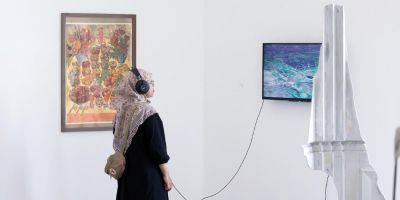Alumna Dr Louise Atkinson embarks on artist residency for a Wellcome Discovery Award funded research project

PhD graduate Dr Louise Atkinson is one of two Artists-in-Residence for Cripping Breath: Towards a New Cultural Politics of Respiration, a research project based at the University of Sheffield.
In response to inequalities highlighted by the COVID-19 pandemic, this innovative research project aims to redefine our understanding of breathing.
Cripping Breath is a five-year co-produced, interdisciplinary project that centres the lives of people who use ventilatory medical technologies. Funded by a Wellcome Discovery Award, the project is led by Dr Kirsty Liddiard at the University of Sheffield alongside a team of researchers, artists and partner organisations.
The project emerges from the global surge in respiratory illness, compounded by the climate emergency and other societal challenges. The research is led by disabled, chronically ill and ventilated people, and addresses the absence of disabled people in contemporary theorisations of respiration and ventilation.

Beaver II portable respirator by the British Oxygen Co. Ltd. 1955 - 1965. Science Museum Group. Image released under a CC BY-NC-SA 4.0 Licence.
Cripping Breath creates the opportunity to challenge and enrich medical and academic discourse about living with compromised respiration. In doing so, it develops Crip perspectives – forms of knowledge production that emerge from lived experiences of disability and chronic illness.
Through bringing together artists, researchers, disability organisations and clinicians, Cripping Breath uses arts-informed, archival, narrative and ethnographic approaches to co-produce new understandings of the experiences of ventilated people.
Some of the project team have already published on how they are embedding Crip time in the research, an aspect that will continue to be shaped throughout.

Louise Atkinson, Untitled, 2022. White ceramic lungs and trachea sculpture, featuring a design illustrating the bronchial passages painted in blue underglaze.
As one of the project’s Artists-in-Residence, Dr Louise Atkinson builds on her doctoral research from the University of Leeds (completed in 2016) which explored archiving, collecting and curating as contemporary art practice.
Currently based in the School of Fine Art, History of Art and Cultural Studies as a Visiting Research Fellow, Atkinson is a visual artist, researcher and facilitator. Her practice explores the relationship between art and ethnography, in which she employs a range of visual and digital media and techniques, including collage, zine making, animation and repeat pattern design.
Her work often incorporates processes of co-production and co-curation, creating new narratives with other people in response to existing archives, collections and histories. In addition to her visual art practice, she is a founder and co-Director of The Highrise Project CIC, an organisation committed to supporting marginalised and minoritised communities in Leeds through art and digital inclusion.

Louise Atkinson, Why Can’t We Dream?, 2020. Textile banner made as part of Living Life to the Fullest.
Louise said:
"I was invited to be on the project team by Kirsty Liddiard after working on Living Life to the Fullest, a previous research project at the University of Sheffield, where I designed a large textile banner in response to insights from disabled young people.
“I also recently created a set of digital images for Kirsty to promote the Participatory Research Network, highlighting the different experiences by people involved in the network.
“My involvement in the Cripping Breath project focuses on facilitating a series of visual arts workshops, working closely with three artist co-researchers with lived experience of respiratory illness to explore the realities of living on and with ventilation.
“Together, we will co-produce new work for a public exhibition. We also plan to incorporate aspects of extended reality and social media to enhance accessibility.
“As part of my research, I have begun creating the Museum of Breathing – an ongoing digital collection hosted on Instagram that captures the histories of breathing through the lens of respiratory illness and mechanical ventilation.”

Louise Atkinson, Untitled, 2023. Digital collage of ‘The Peacock Garden’ by Walter Crane in the shape of lungs on a light blue background.
Louise’s involvement in Cripping Breath also capitalises on her background in socially engaged art and co-production with marginalised and minoritised communities. Louise said:
“As this is a five-year project, I have already had lots of opportunity to spend time learning about the history of respiratory therapies.
“I’m looking forward to working more closely with the rest of the project team and the other artist co-researchers.”

Barnet Mark II ventilator made by W Watson and Son Limited of Barnet, England. 1950 - 1970. Science Museum Group. Image released under a CC BY-NC-SA 4.0 Licence.
Dr Kirsty Liddiard, Senior Research Fellow at the University of Sheffield and the Principal Investigator for Cripping Breath, said:
“Our collective idea to embrace arts approaches in Cripping Breath is about making space to explore stories of ventilation and respiratory illness that can sit outside of the single story of disability, which nearly always centres tragedy in ableist cultures.
“Louise’s approaches will explore accessibility, embodiment and illness, and a range of different art-making techniques with our disabled collaborators living with respiratory illness.
“We are so grateful for her expertise and insight. Her work in the project on the Museum of Breathing is already breaking ground, connecting histories of ventilation and breathing with everyday lived experience.”
More information
Find out about Cripping Breath: Towards a New Cultural Politics of Respiration.
Follow the Museum of Breathing on Instagram @themuseumofbreathing
Find out about Dr Louise Atkinson and her art practice.
Feature image
Drinker iron lung respirator, by Siebe Gorman and Co. Ltd., London, 1930s. Science Museum Group. Image released under a CC BY-NC-SA 4.0 Licence.




